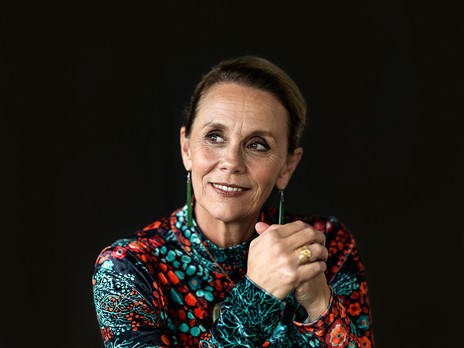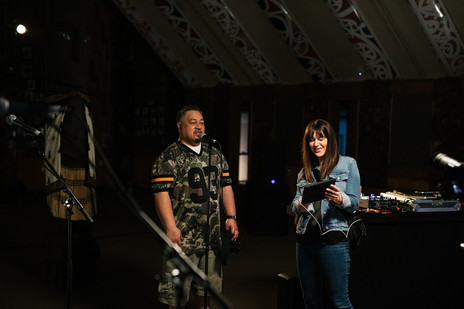
Waiata Anthems began as a bold idea to encourage Aotearoa’s biggest acts to re-record their hits in te reo Māori, but gradually grew into a living, breathing kaupapa that continues to inspire artists and audiences. Since the release of the No.1 charting debut album in 2019 and the launch of the groundbreaking TVNZ series in 2021, Waiata Anthems has sparked an ongoing wave of reo Māori songwriting, documentaries, and live performances. Today, it’s common to see waiata reo Māori in the Aotearoa music charts, heard across social media, and performed proudly on our biggest stages.

Dame Hinewehi Mohi. - Photo: Jane Ussher
Waiata Anthems was the brainchild of Hinewehi Mohi (Ngāti Kahungunu, Ngāi Tūhoe). She took the idea to Adam Holt, CEO of Universal Music NZ, who immediately recognised its power and potential. Holt threw his full support behind the kaupapa and encouraged Mohi to think big. Together, they decided to start at the top by approaching one of the country’s biggest acts, SIX60.
SIX60 enthusiastically came on board and ‘Don’t Forget Your Roots’ was translated to become ‘Kia Mau Ki Tō Ūkaipō’. The single reached the Top 10 and became a centrepiece of the group’s live shows, instantly proving the effectiveness of the approach. Lead singer Matiu Walters believes it led to a fundamental shift in his perspective, as he explained in a Waiata Anthems documentary for the Aotearoa Music Awards 2025.
“I don’t know if I was ever told this explicitly, but there was always this feeling that you don’t do anything in Māori. It might risk your possibility of success. So the process of contributing to Waiata Anthems’ kaupapa, and recording ‘Kia Mau Ki Tō Ūkaipō’ changed me – and us – for the good. What Māori music does to you is inevitable, I think. It is one of the more interesting things about our country and our creative people. I’m happy we played a part in helping to normalise it.”
Mohi gained buy-in from the other major labels in Aotearoa, as well as independent artists to gather songs for a compilation. At first, she relied on her mentor and friend Sir Tīmoti Kāretu to do the translations, using the music to contextualise the language. The resulting album included both Māori and Pākehā artists, with a broad range of genres – from the pop of Benee and Drax Project through to the soulful singing of Stan Walker and Teeks, with even a touch of country via Tami Neilson. Most of the artists had never sung in te reo Māori, but they entered the process with reverence, working closely with mātanga reo (language experts) to ensure the language was delivered with integrity, mana, and respect.
In September 2019, the first Waiata Anthems album was released to mark Te Wiki o te Reo Māori. It debuted at No.1 and generated tens of millions of streams, which showed music listeners were excited to embrace these new versions of their favourite songs. Mohi explained the groundbreaking elements of the project on the E-Tangata website:
“Everyone everywhere was able to access te reo through the waiata. Kura kids finally heard popular music they could relate to. Venues and stadiums across the country resounded with the ‘voice of Aotearoa’, as artists and bands performed their bilingual waiata and audiences joined in, en masse.”

Che Fu with Julia Parnell. - Photo: Alex de Freitas
In 2021, filmmaker Julia Parnell became involved in the project. She explains: “While I was directing the SIX60 movie, we filmed a story about their contribution to the debut Waiata Anthems album with their waiata ‘Kia Mau Ki Tō Ūkaipō’. It was immediately clear how valuable these stories could be. Hinewehi was already in conversation with TVNZ about a series, and we both recognised that audiences wanted more than the songs, they wanted to truly know the artists and their reasons for participating.”

Annie Crummer with Julia Parnell. - Photo: Alex de Freitas
The stories told in the series could be quite moving, especially when it came to musicians with Māori heritage who used the process to reconnect with their roots, as Mohi recalls:
“I’ll never forget Melodownz telling me that filming at his marae in Kaitaia – the first time he’d been there – was one of the most amazing experiences of his life. Since then, he’s taken his daughter there, giving her that connection from birth. Barnaby Weir told us that being part of Waiata Anthems gave him the courage to bring more reo Māori into his work, something he never would have done otherwise. For someone so respected in the music industry, that’s a powerful shift. And for Pākehā artists involved in the project, it has helped them understand more about the unique and beautiful qualities of our culture.”
Parnell felt that being involved in the project was “life-changing”, especially since she sees herself as “a Pākehā deeply committed to sharing responsibility for the future of our indigenous language.” She believes the series format creates the possibility of fostering cultural connection and to encourage change.
In the years that followed, some of Aotearoa’s foremost mātanga reo (language experts) have been brought in to work on songs, including Ruth Smith, Hemi Kelly, Hana Mereraiha and Tawaroa Kawana.
A key aspect of the translation process has been giving the translators the freedom to adjust the literal meaning of the lyrics, as long as the same intent is carried through. A good example of this is The Bleeders’ song ‘All That Glitters’ which was translated as ‘Tahuna Te Ao Mārama’ – this literally translates as ‘Set The World Alight’. Lead singer Angelo Munro (Te Whakatōhea) was intrigued by this process:
“When you interpret a song from English to te reo, you can’t just do a direct translation, because the words won’t have the same rhythm and cadence. I currently work for Ara Poutama [Department of Corrections] as a probation officer and I managed to connect with one of our Māori advisors from Northland, Danny Hauraki … He chose the phrase, ‘tahuna te ao mārama’, which is burning everything down to start afresh. I was really happy with how it turned out. It’s really different from the original and has a unique power of its own.”
In 2023 Lorde came on board the movement and, rather than just doing one song, she undertook a five-track EP, Te Ao Mārama, with songs from her 2021 album Solar Power reworked into te reo Māori. While the project attracted some criticism, it was ultimately a powerful step forward, as Mohi explained in E-Tangata:
“Lorde’s immense global platform has given te reo Māori worldwide recognition. An Irish interviewer noted that his only prior experience of the language was watching the All Blacks’ haka. He hadn’t realised how beautiful te reo Māori is until he heard Lorde’s waiata. And an indigenous American reporter told me it made him dare to dream that one day he might hear his own Navajo language being sung on commercial radio.”
Over time, Waiata Anthems has evolved significantly, says Mohi: “In the early years, we focused on translations of existing songs. Now, we’re seeing original compositions with artists being guided by mātanga reo to craft waiata Māori, which carry depth, metaphor, and beauty. Waiata, either all in te reo Māori or bilingual, provide access to the language for everyone, no matter their language proficiency.”
Geneva AM aka Geneva Alexander-Marsters (Ngāti Kahungunu) attended kōhanga as a child then went to schools that took a bilingual approach; this gave her the grounding to write songs in te reo Māori in her previous group, SoccerPractise. Her first solo single ‘IHO’ was written as part of the 2023 series of Waiata Anthems and she says that being involved “helped me arrive” as an artist. It also allowed her the time to properly develop the song and create a striking video (directed by Keely Meechan), which was important given the personal subject matter:
“The waiata ‘IHO’ is about giving birth – working in te reo Māori helped me share this experience as a wahine Māori. Now, my son will always have a record about our time together as we moved between the different plains of the universe, Te Pō, Te Whaiao ki Te Ao Mārama.”
In 2024, Waiata Anthems launched their Taumata Programme which has aided the production of dozens of original, mostly bilingual waiata. This openness to combining languages allowed the use of te reo to evolve naturally in contemporary music. Take for example the bilingual track ‘Rapua te Mea Ngaro’ by Nikau Grace, which smoothly switches between te reo Māori and English to create an infectious slice of modern pop.
At the same time, the Taumata Programme has supported many original waiata fully in te reo which have been extraordinarily successful, with one streaming favourite being the summer groover ‘Tātarakihi’ by Tawaz, which also features talented neo-soul singer Mohi. The genres in these original waiata have continued to be eclectic – everything from the hip hop of Mā (‘Pūhā me te Porohewa’) to the R’n’B of Jordyn with a Why (‘Māku Anō’) or the electronic beats of Dillastrate (‘Kei Whati Mai Te Marama’).
The TV series has also changed over time, with the shift to a digital-first strategy that has seen the short documentaries and music videos produced for the project receiving millions of streams across platforms. Julia Parnell has witnessed firsthand what a profound effect the Waiata Anthems series has had:
“What’s been most rewarding is seeing the ripple effect. Some artists have told us their involvement completely changed their relationship with te reo Māori, inspiring them to create more waiata reo Māori and bring the language into their daily lives. That’s the magic; the songs don’t just live in the charts, they live in people’s hearts and homes. Now, with our focus on direct-to-audience digital documentaries via our social media channels, we can connect with viewers where they are, nurture deeper relationships with audiences, and build an archive of stories that will inspire, empower, and normalise te reo Māori in music.”
Dame Hinewehi has been overjoyed to find that the Waiata Anthems has had an impact far beyond what she first could have imagined: “It has grown from a bold idea into a dynamic and multifaceted movement. What began as a platform to celebrate waiata reo Māori has become a kaupapa that artists, and audiences alike, feel deeply connected to. Waiata Anthems has shown that when you pair waiata with the stories of the artists, the connection with audiences becomes much deeper. People are fascinated by the process, from songwriting and recording through to release. Artists have found new confidence in their reo, making connections to their marae and iwi, which has created something life-changing for themselves, their whānau, and their listeners.”
--
Links:
Waiata Anthems collection on NZ On Screen
--